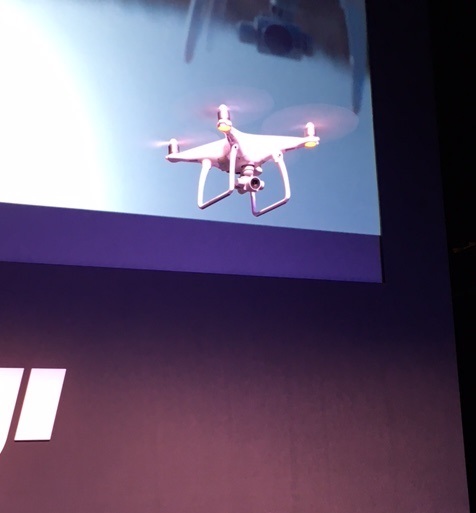At DJI’s media event held in Manhattan on Tuesday, the innovator in easy-to-fly drones and quadcopters unveiled its semi-automated Phantom 4 drone that can track humans and steer clear of objects.

As with most updated versions, the Phantom 4 flies faster, has an improved camera, and boasts a longer flight time. What makes it most noteworthy, however, is the addition of new autonomous features that make it easier to fly and more difficult to crash.
The two optical sensors above the front legs of the drone combined with the computer vision system create a volumetric map of the environment above the device. This allows the Phantom 4 to “see” and react to objects in front of it and ensure it avoids a crash while flying.
If it detects an object within 50 feet, it will begin to slow down; when it is within six feet, the drone will either stop and hover, fly over the object, or fly around it. The Phantom 4’s hazard detection is primarily for its autonomous flight modes, but can also be useful for its new object tracking features.
Aside from the new technologies on the Phantom 4, there are innovative features within DJI’s app itself that can be activated when flying the drone. A new feature called “ActiveTrack” lets the drone lock onto and follow an object simply by tapping on it. The company has applied machine learning algorithm techniques to allow the Phantom 4 to track objects from different angles, with the ability to also orbit an object while maintaining a smooth and steady shot.
Another new feature within DJI’s app is one called “TapFly” that allows users to tap a direction on the tablet, forcing the drone to fly in that direction. If users tap in a different direction, the Phantom 4 will smoothly make the transition and fly that way. The machine learning software automatically adjusts accordingly to give users a steady video.

DJI also unveiled a new Sport mode that gives users access to more power, but does cost them some battery life and stability. The Phantom 4 has a top speed of 45mph in Sport mode, with an ascent speed of 30 feet per second, and a decent speed of 13 feet per second.
To test these features, DJI showed us a demo of the Phantom 4 taking flight within the venue. It should be noted that there were no GPS signals available within the building, which means the drone’s live autopilot demonstration was made possible with the device’s onboard sensors.
During the flight, a woman portraying a jogger came out and the pilot selected her as the subject via DJI’s iPad app. The Phantom 4 took flight, following the jogger around, and other participants attempted to hinder the drone with distractions and obstacles, but it remained stable and consistent.
According to DJI, the company “made the Phantom 4 to be more intelligent” and it has been “redesigned from the ground” up to reduce drag. It comes equipped with a new 5230mAh battery, has a 25 percent higher effective flight time – lasting 28 minutes, and can track its location relative to the ground from 33 feet in the air. With its new push and lock system, the propellers come on and off in less than a second. There’s also a redundant compass and inertial measurement unit (IMU) that provide additional reliability and sensing capabilities.

The Phantom 4 is now available for pre-order on DJI’s website as well as on Apple.com for $1,399. DJI signed a distribution deal with Apple, so the company’s drones will soon be available in Apple’s retail stores. Shipment for the Phantom 4 will begin March 15, with a more widespread availability April 1.
Advertisement
Learn more about Electronic Products Magazine





